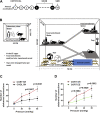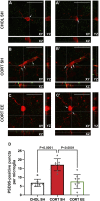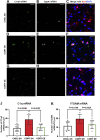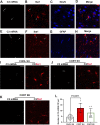An enriched environment reduces chronic stress-induced visceral pain through modulating microglial activity in the central nucleus of the amygdala
- PMID: 34877892
- PMCID: PMC8793868
- DOI: 10.1152/ajpgi.00307.2021
An enriched environment reduces chronic stress-induced visceral pain through modulating microglial activity in the central nucleus of the amygdala
Abstract
Cognitive behavioral therapy (CBT) improves the quality of life for patients with brain-gut disorders; however, the underlying mechanisms of CBT remain to be explored. Previously, we showed that environmental enrichment (EE), an experimental paradigm that mirrors positive behavioral intervention, ameliorates chronic stress-induced visceral hypersensitivity in a rodent model via mechanisms involving altered activity in the central nucleus of amygdala (CeA). In the present study, we investigated whether microglia-mediated synaptic plasticity in the CeA is a potential mechanism underlying the protective effects of EE against stress-induced visceral hypersensitivity. We stereotaxically implanted corticosterone (CORT) micropellets onto the dorsal margin of the CeA shown previously to induce colonic hypersensitivity. Animals were housed in EE cages or standard cages for 14 days after CORT implantation. Visceral sensitivity was assessed via visceromotor behavioral response to colorectal distension. Microglial morphology, microglia-mediated synaptic engulfment, and the expression of synaptic pruning-related signals complement component 1q (C1q), complement component 3 (C3), and C3 receptor (C3R) were measured using immunofluorescence and RNAscope assay. We found that housing CORT implanted rats in EE cages for 14 days attenuated visceral hypersensitivity in both male and female rats as compared with control rats maintained in standard housing. EE reduced CORT-induced microglial remodeling and microglia-mediated synaptic pruning with reduced C1q and CR3, but not C3, expression. Our data suggest that exposure to EE is sufficient to ameliorate stress-induced visceral pain via reducing amygdala microglia-modulated neuronal plasticity.NEW & NOTEWORTHY Clinical studies show that cognitive behavioral therapy (CBT) is effective in ameliorating visceral pain in patient with irritable bowel syndrome (IBS), yet the underlying mechanisms remain unexplored. By using environmental enrichment (EE), an experimental paradigm that mirrors positive behavioral intervention, we demonstrated that microglia-mediated synaptic plasticity in the CeA explains, plays a role, at least in part, in the positive effects of EE to reduce visceral hypersensitivity.
Keywords: abdominal pain; cognitive behavioral therapy (CBT); complement component 3; complement component C1q; irritable bowel syndrome (IBS).
Conflict of interest statement
Research in Beverley Greenwood-Van Meerveld’s Laboratory is supported, in part, by Bayer Consumer Health, Nocion Therapeutics, and TEVA Pharmaceuticals. None of the other authors has any conflicts of interest, financial or otherwise, to disclose.
Figures






Similar articles
-
Amygdala microglia modify neuronal plasticity via complement C1q/C3-CR3 signaling and contribute to visceral pain in a rat model.Am J Physiol Gastrointest Liver Physiol. 2021 Jun 1;320(6):G1081-G1092. doi: 10.1152/ajpgi.00123.2021. Epub 2021 May 5. Am J Physiol Gastrointest Liver Physiol. 2021. PMID: 33949202
-
Inhibition of Microglial Activation in the Amygdala Reverses Stress-Induced Abdominal Pain in the Male Rat.Cell Mol Gastroenterol Hepatol. 2020;10(3):527-543. doi: 10.1016/j.jcmgh.2020.04.020. Epub 2020 May 8. Cell Mol Gastroenterol Hepatol. 2020. PMID: 32408032 Free PMC article.
-
Environmental enrichment prevents chronic stress-induced brain-gut axis dysfunction through a GR-mediated mechanism in the central nucleus of the amygdala.Neurogastroenterol Motil. 2020 Jun;32(6):e13826. doi: 10.1111/nmo.13826. Epub 2020 Feb 21. Neurogastroenterol Motil. 2020. PMID: 32084303 Free PMC article.
-
Corticotrophin-releasing factor 1 activation in the central amygdale and visceral hyperalgesia.Neurogastroenterol Motil. 2015 Jan;27(1):1-6. doi: 10.1111/nmo.12495. Neurogastroenterol Motil. 2015. PMID: 25557223 Free PMC article. Review.
-
Importance of Non-pharmacological Approaches for Treating Irritable Bowel Syndrome: Mechanisms and Clinical Relevance.Front Pain Res (Lausanne). 2021 Jan 21;1:609292. doi: 10.3389/fpain.2020.609292. eCollection 2020. Front Pain Res (Lausanne). 2021. PMID: 35295688 Free PMC article. Review.
Cited by
-
Modulation of visceral pain by brain nuclei and brain circuits and the role of acupuncture: a narrative review.Front Neurosci. 2023 Nov 1;17:1243232. doi: 10.3389/fnins.2023.1243232. eCollection 2023. Front Neurosci. 2023. PMID: 38027491 Free PMC article. Review.
-
Elucidation of the mechanisms of exercise-induced hypoalgesia and pain prolongation due to physical stress and the restriction of movement.Neurobiol Pain. 2023 May 22;14:100133. doi: 10.1016/j.ynpai.2023.100133. eCollection 2023 Aug-Dec. Neurobiol Pain. 2023. PMID: 37274841 Free PMC article. Review.
-
Unraveling the fatigue puzzle: insights into the pathogenesis and management of IBD-related fatigue including the role of the gut-brain axis.Front Med (Lausanne). 2024 Jul 3;11:1424926. doi: 10.3389/fmed.2024.1424926. eCollection 2024. Front Med (Lausanne). 2024. PMID: 39021817 Free PMC article. Review.
-
Cells and circuits for amygdala neuroplasticity in the transition to chronic pain.Cell Rep. 2024 Sep 24;43(9):114669. doi: 10.1016/j.celrep.2024.114669. Epub 2024 Aug 22. Cell Rep. 2024. PMID: 39178115 Free PMC article.
References
Publication types
MeSH terms
Substances
Associated data
Grants and funding
LinkOut - more resources
Full Text Sources
Medical
Miscellaneous

